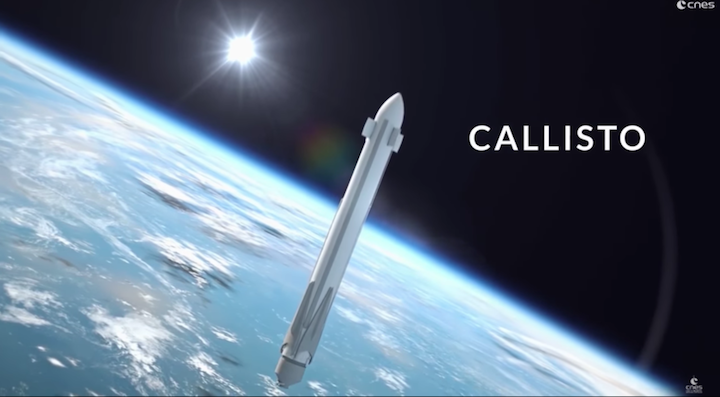8.01.2018

WASHINGTON — Reusable rocketry in Europe took a step forward last year with a funding boost for Prometheus, a program meant to develop a reusable engine manufacturable at one-tenth the cost of the Ariane 5’s first-stage liquid engine. A parallel effort dubbed Callisto could test a European ability to launch, return and refly a rocket from the Guiana Space Centre in South America.
The French and German space agencies (CNES and DLR, respectively) have for the past two years collaborated on a scaled-down rocket that would allow Europe to practice different aspects of recovery and reuse. Callisto’s first flight is planned for 2020.
Callisto officials said the goal of the program is not to create a new vehicle in 2020 — the Ariane 6 is scheduled to debut that same year — but to establish a base of knowledge for future launch vehicles that could, maybe, be reusable.
“Prometheus and Callisto are two key elements of our future launcher preparatory roadmap,” Jean-Marc Astorg, head of CNES’s Launch Vehicles Directorate, told SpaceNews. “Prometheus is a new engine to equip Ariane 6 evolutions or brand-new launchers, and Callisto is developed to learn about reusability in Europe, which we have not done before. We are lacking an experience by operation of recovering a vehicle and reflying it. This is exactly what we would like to do with Callisto.”
Around 1 to 2 percent of Ariane 6’s 3.6-billion-euro ($4.3 billion) development budget is spent on Callisto, Astorg said, describing it as a “modest approach.” Callisto is still in a preliminary design phase, he said, with a full decision on the realization of the demonstrator anticipated this June.
“What we do on Callisto will be very useful to check if reusability is interesting from a cost point of view,” Astorg said. “That will feed our work in the coming years.”
France is leading Callisto’s guidance system and flight software development, Astorg said, and providing the launch site. The Guiana Space Centre won’t need major investments because of the small size of Callisto, he said.
Hansjörg Dittus, executive board member for space research and technology at DLR, told SpaceNews that his agency will bring trajectory, aerodynamic and aerothermodynamic expertise to Callisto, as well as assistance on some subsystem aspects.
Development of a liquid-hydrogen tank would likely be developed in cooperation between the two countries, Astorg said, with industry supplying the engine — which has not been decided — and the liquid-oxygen tank, he said. Callisto’s current configuration calls for a hydrogen engine, Dittus said.
The SpaceX effect
The idea for Callisto did come in part as a response to SpaceX, which has now landed 20 boosters and flown five customers on used rockets, but both Astorg and Dittus describe the project as very different.
“It’s not a copy of what SpaceX is doing,” Dittus said. “In some aspects we are also skeptical [about reusability as] the right path, but we will see what is best and then we can come up with ideas of how we proceed.”
Dittus said Callisto would help understand key technologies that would then influence future studies and investments beyond 2020. Questions, he said, include:
- To what extent do the stages have to be winged?
- What is the throtability of engines?
- What kind of engines would be the best to use for reusability?
“That’s why we do this now,” he said.
Asked whether it was a concern that SpaceX will be much further ahead by the time Callisto flies, Astorg said not being first brings some advantages, such avoiding the use of kerosene in favor of more reusable-friendly fuels like hydrogen or methane. SpaceX’s Falcon 9 Merlin engines use liquid oxygen and kerosene. The U.S. company is investing in a methane and liquid-oxygen engine called Raptor for the Big Falcon Rocket, the successor to the Falcon 9 and Falcon Heavy.
“To be the first to test a technology is very good to be in the media, but it is not always good to be the first in business,” he said. “Today we operate Ariane 5 with 82 successes in a row. We are now close to the first flight of Ariane 6 in 2020. These are our main workhorses to service our needs and for the launch commercial market. For the future we will need to learn from our own experience, we will need to check what others are doing to find the right vehicle for the future.”
“With Ariane 6, industry will reduce the launch cost by two with a new organization and also using technologies tested on CNES demonstrators 10 years ago,” he added. “We are working now on the technologies that will again reduce the launch cost by two in 10 years from now.”
Callisto + Prometheus?

Prometheus was originally a CNES project with industry partner ArianeGroup, but last year evolved into a European Space Agency program with substantially more funding (ESA signed a 75 million euro contract with ArianeGroup in December for the first two prototypes). Callisto, in contrast, is not an ESA program, and its progress is somewhat separate from Prometheus. Astorg said Callisto will need to launch with a different engine because it will be too small for Prometheus, and also because Prometheus will not be ready to fly on Callisto in 2020.
The first vision of Callisto is projected at 13.5 meters high and one meter in diameter, Astorg said. As the project matures, larger versions would fly that could then potentially use Prometheus, he said.
Dittus said if Callisto were to use Prometheus, it would likely be as an ESA project.
Quelle: SN
